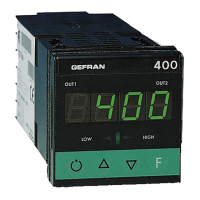2
The function works for single output systems (heating or cooling). The self-tuning action calculates optimum control parameter values during
process startup. The variable (for example, temperature) must be that assumed at zero power (room temperature).
The controller supplies maximum power until an intermediate value between starting value and setpoint is reached, after which it zeros power.
PID parameters are calculated by measuring overshoot and the time needed to reach peak. When calculations are finished, the system
disables automatically and the control proceeds until the setpoint is reached.
How to activate self-tuning:
A. Activation at power-on
1. Set the setpoint to the required value
2. Enable selftuning by setting the Stun parameter to 2 (CFG menu)
3. Turn off the instrument
4. Make sure the temperature is near room temperature
5. Turn on the instrument again
)
.
.)
The procedure runs automatically until finished, when the new PID parameters are stored: proportional band, integral and derivative times
calculated for the active action (heating or cooling).
.
When finished, the Stun code is automatically cancelled.
-The procedure does not start if the temperature is higher than the setpoint (heating control mode) or if the temperature is lower than the
setpoint (cooling control mode). In this case , the Stu code is not cancelled.
-
.
• SELF-TUNING
Peak
T
S.P.
t.a.
Time
Process
Variable
S.P. + t.a.
2
• AUTO-TUNING
Enabling the auto-tuning function blocks the PID parameter settings.
It can be one of two types: permanent (continuous) or single-action
(one-shot).
* Continuous auto-tuning is activated via the Stu parameter (values 1,
3, 5). It continuously reads system oscillations, immediately seeking
the PID parameter values that reduce the current oscillation. It does
not engage if the oscillations drop below 1.0% of the proportional
band. It is interrupted if the set-point is changed, and automatically
resumes with a constant set-point. The calculated parameters are not
saved if the instrument is switched off, if the instrument is switched to
manual, or if the configuration code is disabled. The controller
resumes with the parameters programmed before auto-tuning was
enabled.
p .
* One-shot auto-tuning can be enabled manually or automatically. It is
activated via the Stu parameter (as can be seen on the table, the
values to be set depend on whether Self-tuning or Soft-start is
enabled.). It is useful for calculation of PID parameters when the
system is around the set-point. It produces a variation on the control
output at a maximum of ± 100% of the current control power limited by
h.PH - h.PL (hot), c.PH - c.PL (cold), and assesses the effects in timed
overshoot. The calculated parameters are saved.
.
.
.
.
.
.
.
time
PV
c_Pb
h_Pb
SP+cSP
SP
+100%
Control output
0%
-100%
Control output with proportional action only if proportional heating band
overlaps proportional cooling band.
Control output with proportional action only if proportional heating band
overlaps proportional cooling band.
time
PV
c_Pb
h_Pb
SP+cSP
SP
+100%
Control output
0%
-100%
PV = Process Value SP = Heating Setpoint
SP+cSP = cooling setpoint h_Pb = proportional heating band
c_Pb = Proportional cooling band

